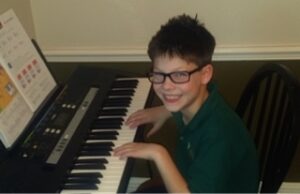Sometimes the most important learning experiences can be missed when we move too fast. Teaching Rubato to “Speedy Piano students” can really help them as a musician in the future, and in general. Here are a few helpful tips to make this learning process easier for you and the student.
Acknowledge They Play Fast
Kids can take things literally and quite personally at times. If you’re going to present their weakness to them you’ll want to consider providing them with a few positives and always compliment their playing. For example, we don’t want to only say “That was way too fast, slow down!” or simply “You played that too fast!” Instead we can try saying something along the lines of “Wow that sounded great really fast! Now let’s slow it down a bit to see how it sounds”. This might encourage the student to think, “I wonder what it does sound like slower” or at least acknowledge the fact that you still complimented them. We want to build confidence, not diminish it.
Gabe, My Speedy Piano Student
I recently started teaching a great boy named Gabe who loves to breeze through some of his exercises. He is a very fast learner. When he starts playing a bit too fast, I let him know is doing a great job, and let him finish playing through the exercise that way. I also let him know I really like the fact he is so eager to get through his exercises. Then I let him know he can play even better if he slows down and takes some time to really pay attention to the exercises even more. This works great, and we both end off on a positive note! (Like what I did there?)
Lights, Camera, Action!
This is a good visual approach. Record a video of you or the student playing the piece really fast. Then record a video of you or the student playing the piece really slow the playback the video so you both can watch it together. Ask the student questions like “Which one did you like better?” or “Which one do you think you/I looked more comfortable playing?” Majority of the time your students will pick the slower video. When they weren’t rushing through the piece, they probably had a bit more time to think about what to play next, and how to play it. Musicians have to pay attention to a lot of things such as notes, rhythm, dynamics, markings, and fingerings all at once when they play.
Use A Metronome
You’ve heard about it. It’s probably the most dreaded, but helpful tool a musician can have. A metronome forces you to play at a constant tempo, or beat. Try putting on the slowest tempo possible and having the student play at that speed, one note at a time. They may get frustrated at first, but with time their rhythm playing and speed will get a lot better. It’s also good to use the metronome in small doses for early beginners. Spend some time with it, and some time without. You can also use it on sections where you’re having the most trouble.
The Road map To Expressive Playing Only Works When There Is A Map.
The last positively effective thing you can do is to clearly layout to the student what they can expect before playing. Before you start a piece or exercise out a book, remind them about speed, the nature or style of the piece, a little history behind it, or remind them about fingerings. Place their hands or instrument in the right position. Do a quick run through of specific parts before they play the whole piece in front of you. A combination of all of these tips can really affect the speed your student plays. Try one at a time to find the right fit.
